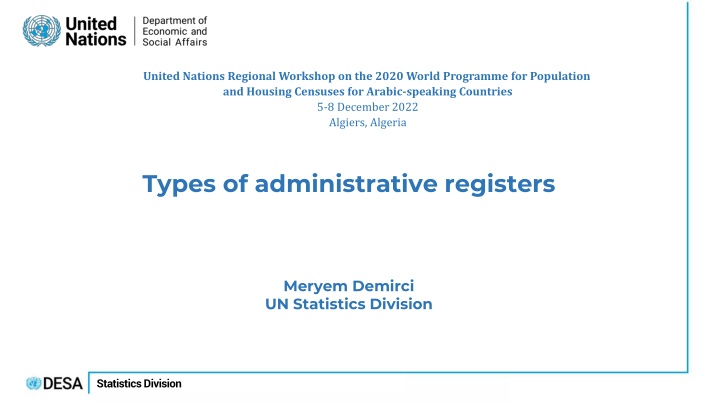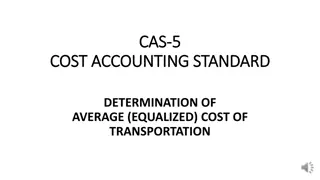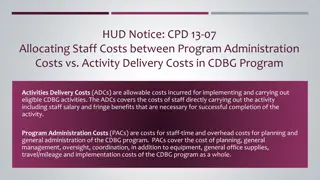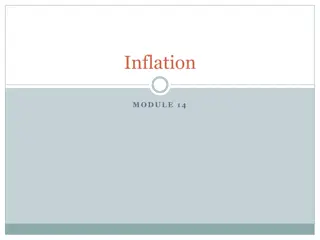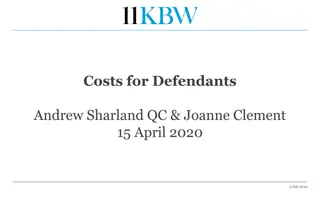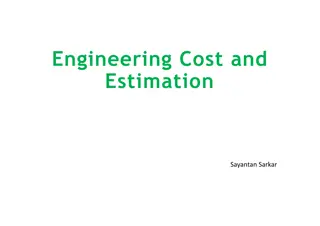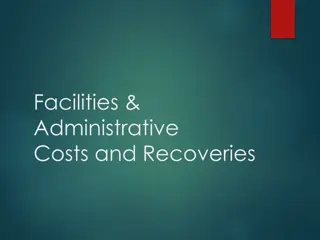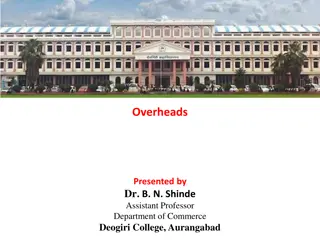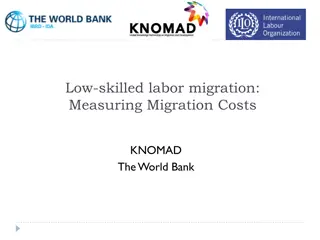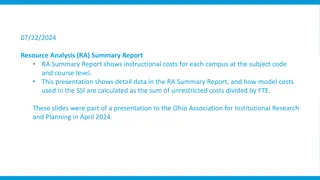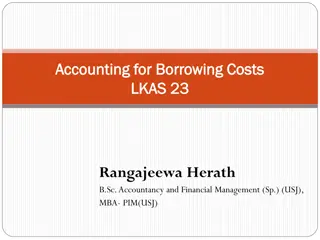F&A Costs and Recoveries in Higher Education
Explore the process of Facilities & Administrative (F&A) costs and recoveries in higher education institutions. Learn about the negotiation process, rate calculation, components, and FY2021 F&A rates. Understand the allocation of costs and the importance of reconciling expenses.
Download Presentation

Please find below an Image/Link to download the presentation.
The content on the website is provided AS IS for your information and personal use only. It may not be sold, licensed, or shared on other websites without obtaining consent from the author.If you encounter any issues during the download, it is possible that the publisher has removed the file from their server.
You are allowed to download the files provided on this website for personal or commercial use, subject to the condition that they are used lawfully. All files are the property of their respective owners.
The content on the website is provided AS IS for your information and personal use only. It may not be sold, licensed, or shared on other websites without obtaining consent from the author.
E N D
Presentation Transcript
United Nations Regional Workshop on the 2020 World Programme for Population and Housing Censuses for Arabic-speaking Countries 5-8 December 2022 Algiers, Algeria Types of administrative registers Meryem Demirci UN Statistics Division Statistics Division
Introduction Administrative registers used for population and housing censuses are in general categorized under two groups: Base Registers Specialized (or supplementary) Registers How we define base and specialized registers? What registers are base ? What registers are specialized? Source: UNSD Handbook on Registers-Based Population and Housing Censuses https://unstats.un.org/UNSDWebsite/statcom/session_53/documents/BG-3e-Handbook-E.pdf Statistics Division
Definitions of Base and Specialized Registers set of population units that are being counted in the census typically persons, dwellings and buildings. Each unit is usually identified by a unique number such as a PIN, real property number or a dwelling number. Base registers are those that hold the basic information relating to the stock of the entire The specialised registers hold the record for each unit, often identified by the same unique number as in the base register, with information necessary for the specific administrative function of the data holders, and from which one or more of the characteristic variables that may be required for the census (such as educational attainment, occupation, disability or income) can be derived. Such specialised registers may not necessarily cover the whole of a census s target population Statistics Division
Any type of censuses links persons with housing units Population count Characteristics of population o Age, sex, marital status o fertility, mortality o International and internal migration o Disability o Education o Employment/unemployment o Occupation (ISCO) /Industry (ISIC) Number of buildings and housing units (inc. occupied and vacant) Characteristics of o Buildings- types of building, construction year and materials, farm building, availability of elevator, etc. o Housing units- conventional/non-conventional dwellings, types of housing unit, rooms, electricity, water supply system, fuel used for cooking, etc. Statistics Division
Types of administrative data sources used for population and housing censuses Base registers Specialized registers Social security/pension Tax Employment, unemployment/jobseeker Education and student Health Border control Foreigners, residence permits . Statistical UNIT is identical throughout data sources, person Population register (PIN) Address/dwelling/building register (Address ID) Establishment/business register (Enterprise ID, farm ID) Statistical UNITS are different Person, Address and Establishment Statistics Division
Base registers for censuses Population Register Main purposes of establishing population register Resident population Citizens + Foreigners Establishing personal identification Deaths Emigration The administration of pensions, health, educational and other services Births Immigration Establishing ownership of a residence or the right to work Each personal record includes: Name, sex, date of birth, Place (country) of birth, Marital status, PIN, Country of citizenship, Residence address, Date of arrival at or departure from that address/country Statistics Division
Base registers for censuses Building and dwelling registers The location of building, usually as a formal address (maybe also geocoordinates) The type and purpose of each building used wholly or partially for residential purposes and whether they are occupied or vacancy or - are used for non-residential purposes, Characteristics of buildings (construction year, size, water/gas/electricity installations, etc.) Regularly updates for new buildings, expanded or demolished old buildings Characteristics of dwellings (size, floor level, ownership/tenure, etc.) Statistics Division
Base registers for censuses Address registers Address register, covering all units Residential buildings/dwellings households and institutional places If non-residential places, types of buildings Such as school, health center, hospital, government offices, establishments No international agreed definition of an address register It is necessary to have a list of places where people might live, to be able to assign a location and link the place to the population register Country practices show different types of relations between address and building/dwelling the address as an attribute in building and dwelling registers the building or register as an attribute of addresses in the address register separate database Statistics Division
Base registers for censuses Business Register A list of enterprises with information about their characteristics could be used for the purpose of the census, especially for producing information on Place of work Industry activity of the establishment in which the job of the employed person (or unemployed person) is located Industrial sector of employment The size of the workforce in terms of numbers of persons employed and employees Statistics Division
Specialized (or supplementary registers) This type of registers: contains records relating to those characteristics for which census information is required and from which the requisite variables for core and non-core topics can be derived using the PIN for record linkage may also help to identify issues of coverage by, in particular, identifying signs of life activities Statistics Division
Key specialized registers Social security or pension registers Registers that are held by official bodies for the purposes of the administration of national social insurance programmes and the allocation of benefits and allowances that encompass, for example, the unemployed, families, pensioners Tax registers Registers that are held by national and local tax authorities for the purposes of the administration and collection of income tax, purchase taxes, property and wealth taxes Employment, unemployment and jobseeker registers These are sources of information from which the country sofficial employment and unemployment figures are usually taken Health registers These are registers (usually) maintained by national or local health authorities for the purposes of providing health-related services and could be used to create data on health status and level of disability to improve the quality of (statistical) population register Statistics Division
Key specialized registers Education and student registers maintained both centrally and by individual educational and academic establishments for the purpose of registering admissions and the performances of students as well as the employment of teaching staff Registers of persons living in institutional places, such as nursing homes, boarding schools, dormitories, and prisons can provide some basic information on members of each population group, including sex, date of birth, ID number, marital status, place of birth, citizenship, etc Registers of foreign nationals or of residence permits may provide information on migrants, year of entry into the country, citizenship and refugees/asylum seekers electoral registers will identify households containing those residents entitled to vote registers of motor vehicles may allow the collection of data on car availability Statistics Division
